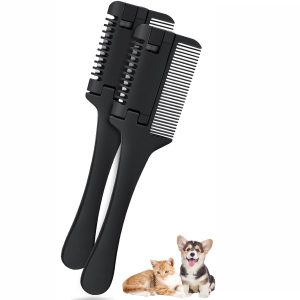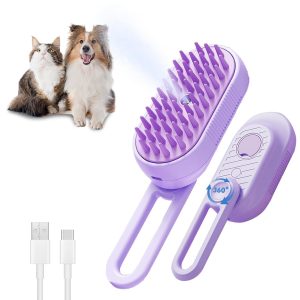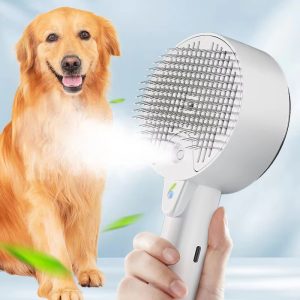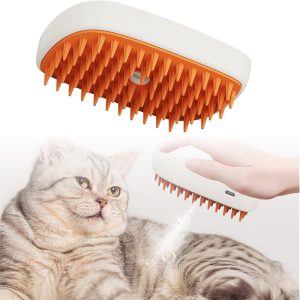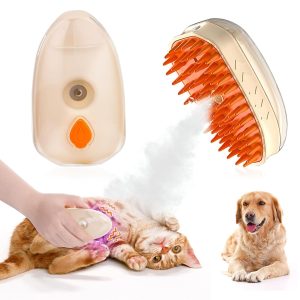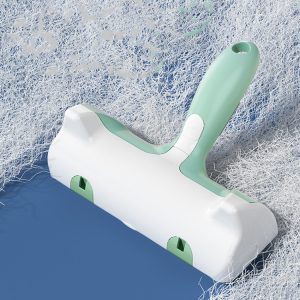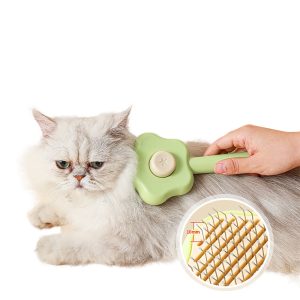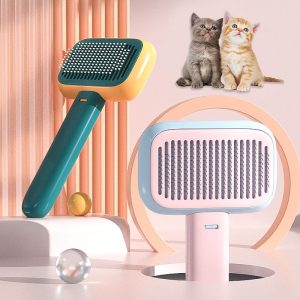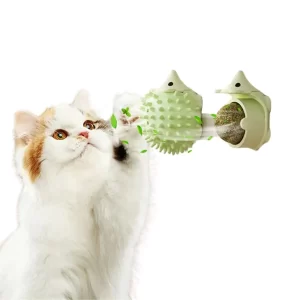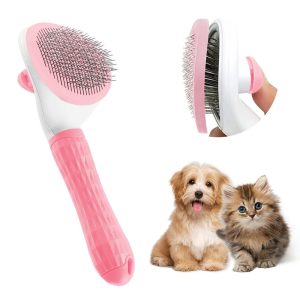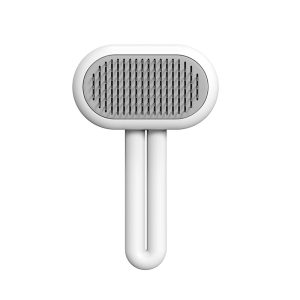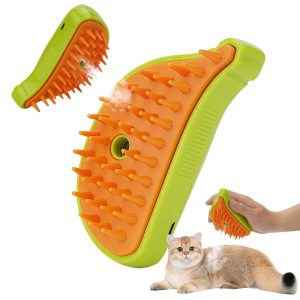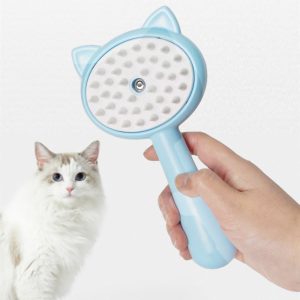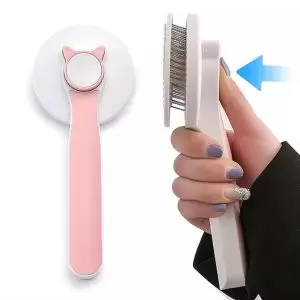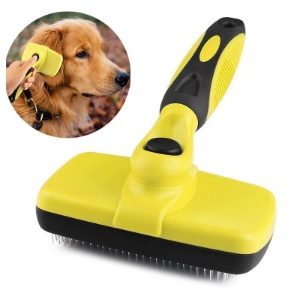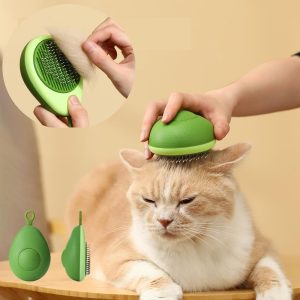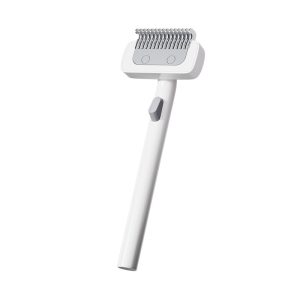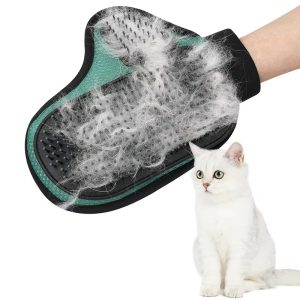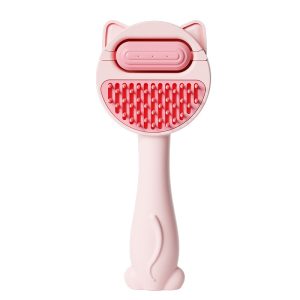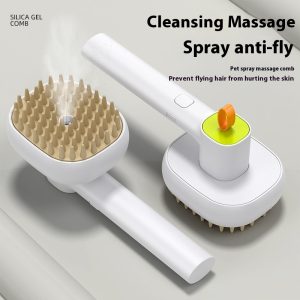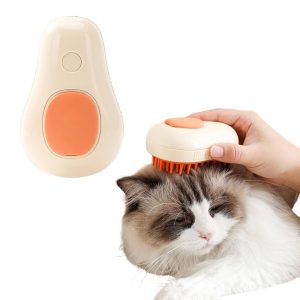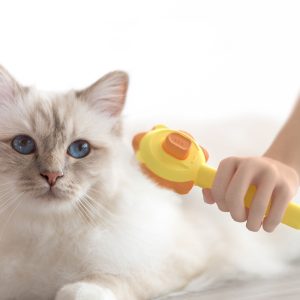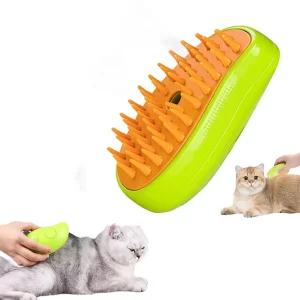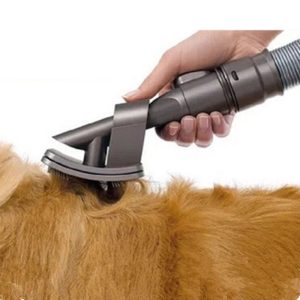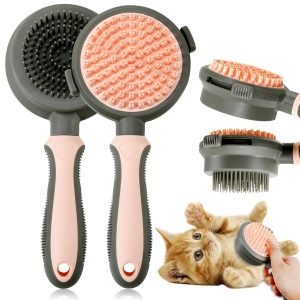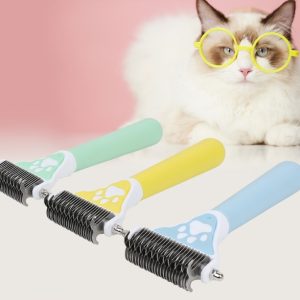Cat Brush
Showing 1–32 of 83 results
2-in-1 Pet Grooming Comb for Dogs and Cats – 2...
Price range: $16.20 through $24.79FREE 1-3 days delivery & FREE returnsSelect options This product has multiple variants. The options may be chosen on the product page3 in 1 Cat Steam Brush for Shedding – Steamy...
$14.76FREE 1-3 days delivery & FREE returnsSelect options This product has multiple variants. The options may be chosen on the product page3-in-1 Cat and Dog Electric Steam Brush with Sprayer, Massage,...
$26.38FREE 1-3 days delivery & FREE returnsSelect options This product has multiple variants. The options may be chosen on the product page3-in-1 Cat Steam Brush, Rechargeable Pet Brush with Water Tank...
$13.69FREE 1-3 days delivery & FREE returnsAdd to cart4-in-1 Cat Steam Brush for Shedding, Massage, and Grooming with...
$17.87FREE 1-3 days delivery & FREE returnsAdd to cartBed Cat Hair Cleaner for Pet Supplies – Easy-to-Use Cat...
$32.58FREE 1-3 days delivery & FREE returnsAdd to cartCartoon Pentagram Shape Cat Combs – Pet Hair Removal Massaging...
$14.99FREE 1-3 days delivery & FREE returnsSelect options This product has multiple variants. The options may be chosen on the product pageCat and Dog Cat Self Groomer, Wall Corner Scratcher Massage...
$15.29FREE 1-3 days delivery & FREE returnsSelect options This product has multiple variants. The options may be chosen on the product pageCat and Dog Hair Brush – Stainless Steel Massage Comb...
$17.57FREE 1-3 days delivery & FREE returnsSelect options This product has multiple variants. The options may be chosen on the product pageCat and Dog Hair Remover Brush – UVC Sterilization Pet...
$24.69FREE 1-3 days delivery & FREE returnsAdd to cartCat and Kitten Self Groomer Toy, Catnips Grooming Teaser Cartoon...
$12.76FREE 1-3 days delivery & FREE returnsSelect options This product has multiple variants. The options may be chosen on the product pageCat Brush with Release Button, Pet Hair Removal Tool for...
$12.82FREE 1-3 days delivery & FREE returnsSelect options This product has multiple variants. The options may be chosen on the product pageCat Brush, Dog Brush, Pet Hair Cleaner Brush, Pet Grooming...
$17.98FREE 1-3 days delivery & FREE returnsSelect options This product has multiple variants. The options may be chosen on the product pageCat Brush, Grooming Comb, Self Cleaning Cat Slicker Brushes for...
Price range: $12.65 through $17.65FREE 1-3 days delivery & FREE returnsSelect options This product has multiple variants. The options may be chosen on the product pageCat Ear Pet Hair Removal Brush, Electric Floating Brush for...
$15.76FREE 1-3 days delivery & FREE returnsSelect options This product has multiple variants. The options may be chosen on the product pageCat Grooming Brush – Self Cleaning Slicker Brush for Dogs...
$14.87FREE 1-3 days delivery & FREE returnsSelect options This product has multiple variants. The options may be chosen on the product pageCat Grooming Brush – Self Cleaning Slicker Brushes for Cats...
$12.79FREE 1-3 days delivery & FREE returnsSelect options This product has multiple variants. The options may be chosen on the product pageCat Grooming Brush, Self Cleaning Slicker Brushes for Dogs Cats...
$18.46FREE 1-3 days delivery & FREE returnsSelect options This product has multiple variants. The options may be chosen on the product pageCat Grooming Brush, Self Cleaning Slicker Brushes For Dogs Pet...
$13.34FREE 1-3 days delivery & FREE returnsSelect options This product has multiple variants. The options may be chosen on the product pageCat Grooming Comb – Portable Massage Brush with One-Button Hair...
$18.98FREE 1-3 days delivery & FREE returnsSelect options This product has multiple variants. The options may be chosen on the product pageCat Hair Comb for Grooming, One-Touch Hair Removal Comb for...
$13.25FREE 1-3 days delivery & FREE returnsAdd to cartCat Hair Floating Comb Brush – Professional Pet Grooming Tool...
$18.67FREE 1-3 days delivery & FREE returnsSelect options This product has multiple variants. The options may be chosen on the product pageCat Hair Removal Glove – Pet Bath Massage Glove for...
$16.79FREE 1-3 days delivery & FREE returnsSelect options This product has multiple variants. The options may be chosen on the product pageCat Massage Brush – Pet Comb Brush for Cleaning, Hair...
$19.99FREE 1-3 days delivery & FREE returnsSelect options This product has multiple variants. The options may be chosen on the product pageCat Soft Teeth Electric Massage Spray Comb – Pet-Friendly Wash-Free...
$17.81FREE 1-3 days delivery & FREE returnsSelect options This product has multiple variants. The options may be chosen on the product pageCat Steam Brush Steamy Dog Brush 3 In 1 Electric...
Price range: $11.38 through $22.53FREE 1-3 days delivery & FREE returnsSelect options This product has multiple variants. The options may be chosen on the product pageCat Steam Brush, Avocado Shape Hair Brush for Cat &...
$17.34FREE 1-3 days delivery & FREE returnsSelect options This product has multiple variants. The options may be chosen on the product pageCats Grooming Deshedding Comb for Cats Remove Loose Hair Cats...
$19.69FREE 1-3 days delivery & FREE returnsSelect options This product has multiple variants. The options may be chosen on the product pageCHEEOKUO 3 In1 Cat Steamy Brush, Self Cleaning Steam Cat...
Original price was: $23.78.$16.19Current price is: $16.19.FREE 1-3 days delivery & FREE returnsAdd to cartCompatible for Dyson V10 V11 V12 V15 V8 V7 ,Vacuum...
$29.86FREE 1-3 days delivery & FREE returnsSelect options This product has multiple variants. The options may be chosen on the product pagedeusknoy 2 in 1 Double Side Cat Brushes for Indoor...
$23.46FREE 1-3 days delivery & FREE returnsSelect options This product has multiple variants. The options may be chosen on the product pageDog Comb for Shedding and Knot Removal – Pet Grooming...
$18.67FREE 1-3 days delivery & FREE returnsSelect options This product has multiple variants. The options may be chosen on the product page
Cat Grooming Brush for Long & Short Hair
Are you looking for the best cat brush? Look no further than PetsCatHouse, where an excellent assortment of cat brushes awaits to cater to your feline friend’s grooming needs.
Regardless of whether your pet boasts short or long hair or a coat that tends to shed abundantly, we have the best grooming tool for you.
Regularly brushing your cat minimizes matting and aids in the even distribution of their natural oils, resulting in a lustrous coat.
Cat Brush for Long Hair
Consider your cat’s breed and coat type when selecting a cat brush. For long-haired cats like the majestic tabby, a pin brush with long pins and protective balls at the ends is an ideal choice.
This brush is designed to penetrate deep to the skin, effortlessly gliding through the fur. In cases of severe matting, use a wide-tooth comb to tackle stubborn tangles before proceeding with your regular cat hairbrush.
Daily brushing is recommended for long-haired cats to maintain a silky and smooth coat.
Cat Brush for Short Hair
For short-haired cats with glossy coats, opt for a soft-bristled short-hair cat brush to avoid inadvertently scratching your pet.
Another effective tool for short-haired grooming is the slicker, featuring short pins that make it a fantastic cat-deshedding brush.
Some slickers are self-cleaning, and most short-haired cats typically require brushing once a week.
If your cat leaves fur tufts reminiscent of tumbleweeds around the house, a deshedding cat hair brush can be a game-changer. These brushes penetrate the topcoat, capturing loose undercoat hairs beneath.
Deshedding brushes are available for both long-haired and short-haired cats, with many featuring self-cleaning properties. Consider using regular cat brushes before employing undercoat deshedding tools.
For cats resistant to traditional brushes, PCH offers innovative solutions to simplify grooming.
Cat Grooming Gloves, equipped with silicone or pin-style bristles on the palms, provide a petting experience that many cats enjoy. These gloves transform grooming time into a pleasurable experience, eliminating the need for your cat to run and hide.
PetsCatHouse also offers Self-Grooming Cat Toys that double as grooming tools. The cat corner brush, attachable to most corners in your home, features a brushing attachment that cats love to rub against. Some even come with a catnip compartment, making them nearly irresistible to your feline companion. Similarly, Self-Grooming Cat Arches provide a soothing experience for your cat while capturing loose hair, making your life a little more manageable.
The Importance of the Best Cat Brush
Cats are renowned for their independent and graceful nature. While they may meticulously groom themselves, they can still benefit greatly from the help of a trusty companion – the cat brush.
This unassuming tool plays a pivotal role in maintaining a cat’s health and happiness. In this article, we’ll delve into the significance of cat brushing, exploring its benefits and the best practices to keep your feline friend content and flourishing.
1. Promoting Healthy Fur
Regular brushing helps in removing dirt, debris, and loose fur from your cat’s coat. This not only keeps your cat clean but also prevents matting, which can be uncomfortable and even painful for your feline friend. By removing tangles and knots, you are ensuring that air can circulate freely through their fur, promoting a healthy and shiny coat.
2. Preventing Hairballs
Cats are meticulous groomers, and during their grooming sessions, they often ingest loose fur. This can lead to the formation of hairballs in their digestive tract, causing discomfort and potential health issues. Brushing your cat helps in reducing the amount of loose fur they swallow, thereby minimizing the occurrence of hairballs.
3. Strengthening the Bond
Brushing your cat can be a bonding experience for both of you. Through gentle strokes and soothing words, you create a positive association with the brush, making your cat more receptive to the process. Regular brushing sessions can become moments of relaxation and connection, strengthening the bond between you and your pet.
4. Early Detection of Health Issues
Regular brushing allows you to familiarize yourself with your cat’s body. During these sessions, you can check for any abnormalities such as lumps, bumps, or skin issues. Detecting these problems early can be crucial for timely veterinary intervention, ensuring your cat’s overall well-being.
5. Stress Reduction
Believe it or not, cats can get stressed, especially if they have a long or matted coat. Brushing helps in removing tangles and mats, preventing discomfort and stress. Additionally, the gentle rhythm of brushing can have a calming effect on your cat, making them feel more relaxed and content.
Choosing the Right Cat Brush
When it comes to cat brushes, there are various types available, each designed for specific purposes. Slicker brushes are excellent for removing tangles, while bristle brushes work well for short-haired cats. For long-haired breeds, a wide-toothed comb is ideal. Always choose a brush that suits your cat’s fur type to make the brushing experience comfortable and effective.
What to Look for in a Cat Brush?
Bristles
For cats with long hair, you’ll also need a comb or slicker with curved prongs that can easily go into the undercoat and assist avoid matting and knots. attempt an alternative bristle material if the first one you attempt doesn’t work because some cats could react better to other textures.
Ease of Cleaning
Your grooming sessions will be more fruitful if you choose clean instruments.Like a human hairbrush, you might have to use your fingers to remove hair from a cat brush. To remove any last bits of dander, you may also soak your cat brushes and combs in a solution of cat shampoo and water. A few of the slickers we selected have a button on the handle that pushes the collected debris off of the prongs.
Removing Mats and Tangled Fur
Fur mats typically develop in sensitive, hard-to-reach areas, such as under the front and back legs close to the butt. Concentrate on one mat at a time, use your fingers to separate it, then carefully go through it with a strong metal comb.
Why Use a Cat Brush?
Regular brushing not only keeps your cat’s coat tangle-free but also reduces hairballs and prevents matting. It strengthens your bond with your pet while ensuring their fur stays soft and manageable.
How to Use:
- Brush in the direction of the hair growth for optimal comfort.
- Use 2-3 times per week to prevent excess shedding.
- For longer-haired cats, focus on areas prone to tangles, like the belly and legs.
Perfect for Cats of All Ages!
Whether you have a playful kitten or a senior feline, our cat brush ensures a stress-free grooming experience. Say goodbye to excessive fur and hello to a cleaner home!
FAQs about Cat Brush
How do you clean cat brushes?
To clean most cat brushes, remove the hair by hand and give them a frequent wash in warm, soapy water. Pay attention to the directions that come with the specific cat brush you own, as different materials could require different handling techniques.
What are the best cat brushes?
The best cat brushes will be soft on your cat’s skin and comfortable for you to handle. To assist avoid feline discomfort and shedding all over your house, they should efficiently and rapidly remove extra hair and knots from your cat. Consider the type of coat your cat has when selecting a cat brush style. For long-haired cats, a slicker brush, de-matting comb, or undercoat brush may be ideal; for cats with shorter, thinner coats, a basic bristle brush or grooming glove is usually sufficient
What is the best tool to remove matted fur from a cat?
Using your fingers, carefully separate the mats as much as you can, one mat at a time. Apply a small amount of talcum powder and carefully go through the mat with a strong metal comb fitted with fine teeth.
How often should you brush your cat?
If your cat is a long-haired breed, you should brush her once or more a day; if she has shorter hair, brush her a few times a week. To minimize shedding, you might need to brush your cat more frequently during shedding season or if there is an allergy sufferer in your home. Some cats with short hair may require very little, if any, brushing. Talk to your vet or a grooming professional about the right amount of brushing for your cat if you are unsure.
Do cats like to be brushed?
Most of cats enjoy having their hair combed and the attention that comes with it. It could take some time for other cats—including ones that have never been brushed—to become used to the notion of being brushed. Take your time and use a brush with soft bristles to prevent frightening or upsetting your cat.
Does brushing a cat help to minimize shedding?
Yes, giving a cat a gentle brushing with a brush with soft bristles, such as our pick for the Best In general, a cat’s coat will shed hair, which can be collected by using the Mars Boar Bristle Cat Hair Brush once or twice a week. It will gather on the brush’s head, minimizing the quantity of hair found throughout your house. The hair that collects on the brush after each brushing session needs to be thrown in the garbage.
